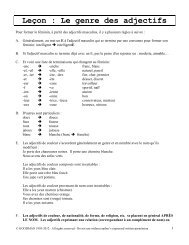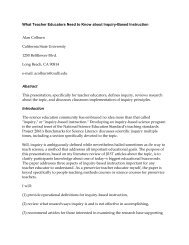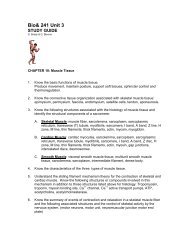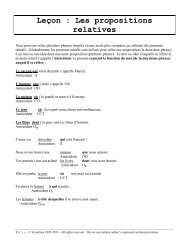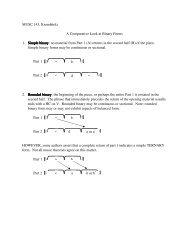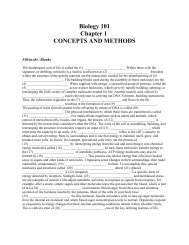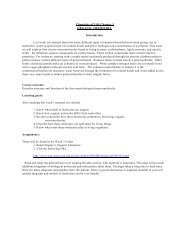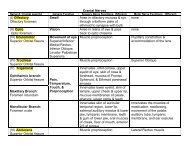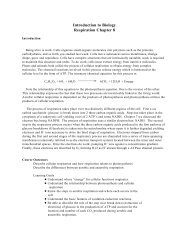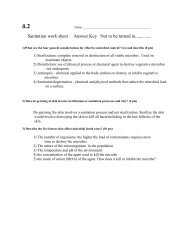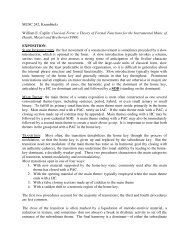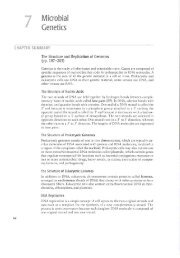Harmonic Sequences
Harmonic Sequences
Harmonic Sequences
You also want an ePaper? Increase the reach of your titles
YUMPU automatically turns print PDFs into web optimized ePapers that Google loves.
<strong>Harmonic</strong> <strong>Sequences</strong>
<strong>Harmonic</strong> <strong>Sequences</strong><br />
• <strong>Harmonic</strong> sequences are short, melodicharmonic<br />
patterns that are repeated on<br />
different scale steps. The strong linear or contrapuntal<br />
direction of the melodic sequence<br />
dictates the chord progression and therefore<br />
overrides the chords‟ normal tendencies.<br />
• <strong>Harmonic</strong> sequences consist of a two-chord<br />
pattern that is repeated.
<strong>Harmonic</strong> <strong>Sequences</strong>:<br />
• Occur in both diatonic and chromatic versions<br />
(i.e., using secondary function chords).<br />
• May use seventh chords instead of triads for<br />
one or both chords of the initial pattern.<br />
• May alternate between root-position chords<br />
and inversions. However, once the initial<br />
pattern is stated, the pattern tends to be<br />
upheld.
The Four Primary <strong>Harmonic</strong><br />
<strong>Sequences</strong>.<br />
•Descending Fifths (aka circle of 5ths)<br />
•Ascending Fifths<br />
•Descending 5-6 (aka Falling Thirds)<br />
•Ascending 5-6 (rising by step)
The Descending 5ths Sequence:<br />
• Is the most important (and most often used) of the<br />
four sequence types, because it is based on the<br />
most important chord progression in tonal music:<br />
the descending fifth.<br />
• It often „cycles‟ through all seven chords of the<br />
scale.<br />
• It‟s found in a variety of forms: diatonic,<br />
chromatic, using inversions, and 7 th chords.<br />
• Each repeated pattern is a step lower than its<br />
predecessor.
The initial pattern of a descending 5ths<br />
sequence may be as simple as:
When the pattern repeats, it appears a step<br />
lower. Notice that each voice part’s voice<br />
leading in the initial pattern is maintained.
Two more repetitions of the pattern and the<br />
chord progression cycles all the way back to I.
Here’s the same circle of 5ths sequence,<br />
but this time stated in minor:
Here‟s a descending 5ths sequence<br />
in the minor mode:
The Ascending 5ths Sequence<br />
• Because root motion by ascending 5ths does not establish a<br />
sense of tonality, this sequence does not cycle through all<br />
seven chords.<br />
• In the major mode the sequence usually takes the form of:<br />
IÿV, iiÿvi, iii. Note that if the sequence continued, the<br />
next two chords, viiøÿIV create root progression by tritone.<br />
• In the minor mode, the first repetition of the pattern would<br />
be iiøÿVI, root motion by tritone, so these two chords are<br />
skipped and the sequence continues: iÿV | IIIÿVII, ivÿi<br />
• When the initial pattern repeats, it will appear a step<br />
higher.
The Ascending 5ths sequence in the major<br />
mode: basic voice leading
Here‟s an example of an ascending 5ths sequence<br />
in the major mode. As commonly happens, the<br />
sequence breaks off when we reach the iii chord.
In this excerpt Handel extends the ascending 5 th<br />
sequence one more fifth than usual, but he changes the<br />
expected chord (viiø) into a secondary dominant (V/iii),<br />
which here acts as back-relating dominant. That is, it‟s<br />
the secondary dominant of the chord in front of it.
Here‟s an ascending 5ths sequence in the minor<br />
mode. As is typical, the progression iiøÿVI is<br />
omitted.
The descending 5-6 sequence (aka “falling 3rds”) is driven by a<br />
stepwise melodic line, usually in the bass. The soprano is set<br />
either in parallel 10ths with the bass, or it creates an alternating<br />
pattern of 10-6 intervals. With each repetition, the pattern<br />
appears a 3 rd lower.
But the term “5-6” arises because of alternating<br />
intervals of a 5 th and 6 th between the bass and one of the<br />
upper voices. The sequence yields the progression.<br />
Note the pattern of alternating root-position and firstinversion<br />
chords.
Here‟s an example in the major mode. Note that the<br />
sequence starts on the upbeat.
The descending 5-6 sequence is also commonly found<br />
in a root-position variant. All the chords are in root<br />
position and the soprano almost always descends by<br />
step.
The most famous rendition of the root-position version<br />
of the descending 5-6 sequence is Pachelbel‟s Canon in<br />
D. But here‟s the same sequence used by Handel. (The<br />
dotted ties indicate implied suspensions.)
The ascending 5-6 sequence also gets its name from a<br />
pattern of alternating intervals of the 5ths and 6ths<br />
Note: the pattern can also be expressed as 6-5.
This example starts with the interval of a 6 th and<br />
is most visible in the bass and tenor parts.
The ascending 5-6 sequence is commonly found in a<br />
root-position variant. The root-position variant provides<br />
for a much more interesting bass line.




